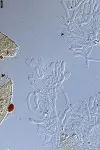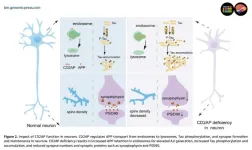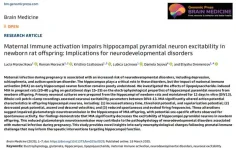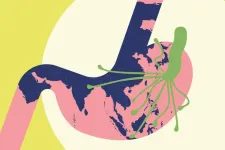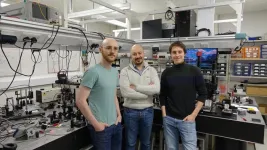(Press-News.org) Although fungi of the genus Piloderma are common, scientists have now discovered five previously unknown species. One of these is one of the most widely distributed species in Northern Europe, while another is found only in old-growth forests. The discoveries, published in Fungal Biology, show that diversity in this genus is much greater than previously thought and that some of its species are at risk of disappearing as old-growth forest is logged.
Many of the fungi of the genus Piloderma are among the most common fungal species in Sweden. They are associated with trees in a form of symbiosis called mycorrhiza, where they help their hosts acquire water and nutrients in return for sugar. This makes them very important to the functioning and growth of forest ecosystems.
Researchers have now discovered five new species in the genus, which are described in a study published in Fungal Biology. With an additional seven new species that they published last year, Piloderma has now tripled in size, and grown from being a small to a medium-sized genus.
“We have seen for a long time how important Piloderma species appear to be in mycorrhizal symbiosis, and that the diversity of species in this genus far exceeds the number of named species. It’s satisfying that we can now, through delimitation and naming, make these species visible and communicate about them” says Martin Ryberg, professor at the Department of Organismal Biology.
Rare species found in old-growth forest
One of the new species described is Piloderma fugax. It appears to be rare and was found close to Gällivare in Sweden and in Trøndelag in Norway. Its ecology deviates from other species in the genus, as it only grows in old-growth forests. Since it is also small and difficult to detect, the researchers have given it the name fugax, which means shy, hidden or fleeting in Latin.
“It’s interesting but also a little frightening to see that in a genus like Piloderma, where we previously thought all species were common, there are such hidden old-growth forest species. They risk disappearing as the forest landscape is transformed from natural forests to plantations. Because of their insignificant size, no one have discovered them. I hope that our research can assist in making more people aware of and marvel at this kind of species and forests” says Sten Svantesson, lead author of the study.
Compared DNA to identity new species
In the study, the researchers looked for new species in Sweden, Norway, Finland and Lithuania. They collected fruiting bodies and went through collections already made in other research projects. Then potentially new species were compared with existing species to establish that they were in fact new.
“Species are deemed to be new if we, based on DNA sequencing, consider that we can establish that they are biologically distinct from existing species, that is, if no reproduction occurs between them. We then use data from soil and root tip samples uploaded into international gene databases from previous studies to obtain more information about their geographical distribution and ecology,” says Sten Svantesson.
Among the five new species found, was also Piloderma luminosum. This very common species was found to be easily recognisable by its almost luminous yellow to orange fruiting bodies. It has been distinguished from a species complex that includes the equally common species Piloderma byssinum. The difference between the two species is small but consistent.
“These two species often grow right next to each other and are commonly occurring in soil and root tip samples. By distinguishing them as different species, their differentiation can now be investigated – whether they have developed different niches or whether other factors have led to one original species becoming two,” says Sten Svantesson.
Contact details
Sten Svantesson, postdoctoral researcher at the Department of Organismal Biology and Museum Curator at the Museum of Evolution at Uppsala University
E-mail: sten.svantesson@ebc.uu.se
Cell phone number: +46 703095588
END
New ‘shy’ fungus found in old-growth forest
2025-03-18
ELSE PRESS RELEASES FROM THIS DATE:
Some nicotine pouch flavors much more addictive than others
2025-03-18
A new paper in Nicotine & Tobacco Research, published by Oxford University Press, indicates that different nicotine pouches, which have become very popular in recent years, particularly among young people, may influence user preferences very differently. An investigation using rats finds some flavors lead to much more nicotine consumption than others.
According to the World Health Organization, tobacco use remains a major global health threat, with 1.3 billion tobacco users, and 8 million tobacco-related deaths annually. ...
Low doses of antibiotic work just as well as higher ones to treat rare type of chronic hair loss
2025-03-18
Small amounts of a common antibiotic and anti-inflammatory drug can curb symptoms where a misplaced immune reaction (e.g., autoimmunity) can cause permanent hair loss, a new study shows. This regimen may also come with fewer side effects than higher doses of the medication.
Led by researchers at NYU Langone Health, the study explored lymphocytic scarring alopecia, a rare skin condition in which the body’s immune cells damage hair follicles, leading to hair loss and scarring. Physicians typically treat this chronic disorder with relatively high doses of the antibiotic doxycycline, often ...
Social media pressures could make friendship a full-time job
2025-03-18
Friendships are critical parts of our lives. Staying in touch with friends online is crucially important, especially for teenagers. Fostering friendships online, however, takes time and might require near constant availability, which can cause digital stress that can arise when expectations on social media are not met. This in turn, can lead to conflicts among friends.
New research published in Frontiers in Digital Health by scientists in Italy highlights how social media expectations within friend groups and digital stress shape adolescent friendships and conflicts over time.
“We show that adolescents’ perceptions of social media norms and perceptions of unique features ...
CD2AP and Alzheimer’s disease: A key regulator of neurodegeneration and potential therapeutic target
2025-03-18
XIAMEN, China, 18 March 2025 – A groundbreaking peer-reviewed Thought Leaders Invited Review article in Brain Medicine (Genomic Press, New York) explores how CD2-associated protein (CD2AP) contributes to Alzheimer’s disease (AD), one of the most devastating neurodegenerative disorders affecting millions worldwide. CD2AP, initially identified for its role in cellular transport and cytoskeletal architecture, has now emerged as a crucial factor in AD pathology.
Genome-wide association studies (GWAS) have established CD2AP as a major genetic risk factor for late-onset Alzheimer’s disease ...
Maternal infection disrupts newborn brain development: A link to neurodevelopmental disorders
2025-03-18
BRATISLAVA, Slovakia, 18 March 2025 – A pioneering peer-reviewed research study published in Brain Medicine provides compelling evidence that maternal infections during pregnancy can have lasting effects on offspring brain function. Researchers from the Slovak Academy of Sciences investigated the impact of maternal immune activation (MIA) on hippocampal pyramidal neurons in newborn rat offspring and found that prenatal inflammation significantly impairs neuronal excitability. These changes in brain function may underlie the increased risk of neurodevelopmental disorders associated with maternal infections.
“Maternal ...
inait announces collaboration with Microsoft to deploy novel AI based on digital brains across industries
2025-03-18
Zürich/Lausanne, Switzerland – 18 March 2025 – inait today announced a collaboration with Microsoft to accelerate the development and commercialization of inait’s innovative AI technology, using its unique digital brain AI platform. The collaboration will focus on joint product development, go-to-market strategies, and co-selling initiatives, initially targeting the finance and robotics sectors.
inait's AI technology, born from decades of neuroscience research offers a paradigm shift in artificial intelligence. Its “brain programming language” and ability to learn from experience and understand cause and effect delivers cognitive ...
The Open Brain Institute announces the dawn of a new frontier in neuroscience
2025-03-18
LAUSANNE, March 18, 2025 – The Open Brain Institute (OBI) launches today as a groundbreaking non-profit organization, transforming neuroscience from the physical to the virtual world. Building on the pioneering achievements of the EPFL’s Blue Brain Project, OBI opens the era of simulation neuroscience—empowering researchers to build and simulate digital brains with unprecedented detail, scale, and speed.
AI has been given access to the software recipe to build digital brains, providing natural language support to researchers to explore, build and ...
Helicobacter pylori treatment practices in the Asia-Pacific region
2025-03-18
Helicobacter pylori bacteria is considered to be the main cause of gastric cancer, with the infection rate particularly high in the Asia-Pacific region. Approximately 90% of cases are linked to H. pylori bacterial infections, but preemptive eradication can reduce the incidence of gastric cancer by 30-40%.
However, the increase in antimicrobial drug-resistant bacteria used in eradication therapy is a major issue. In addition, while secondary prevention through endoscopic examinations is also important for the early detection of gastric cancer, it is not clear to what extent Asia-Pacific practitioners recognize its importance.
An international ...
Nearly one in ten unsure if they have Long Covid
2025-03-18
UNDER EMBARGO UNTIL 00:01 AM UK TIME ON TUESDAY 18 MARCH 2025
Almost one in ten people (9.1%) in England think they could have Long Covid but aren’t sure, according to a new analysis of NHS England survey data by the University of Southampton.
Researchers also found that 4.8% of people reported having Long Covid, with higher rates among people living in deprived areas, people with particular ethnic backgrounds, parents or carers, and those with another long-term condition.
The findings are published today [18 March] ...
Scientists unlock new dimension in light manipulation, ushering a new era in photonic technology
2025-03-18
Researchers at Heriot-Watt University have made a ground-breaking discovery paving the way for a transformative era in photonic technology.
For decades, scientists have theorised the possibility of manipulating the optical properties of light by adding a new dimension—time. This once-elusive concept has now become a reality thanks to nanophotonics experts from the School of Engineering and Physical Sciences in Edinburgh, Scotland.
The team’s breakthrough emerged from experiments with nanomaterials known as transparent conducting oxides (TCOs) - a special ...

